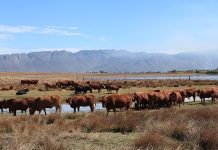Government efforts to speed up redistribution of white-owned farms are gaining momentum with the announcement of a fresh round of forced sales, changes to expropriation law to force the hand of unwilling sellers and the creation of a multibillion-rand state land buying entity.
Land and agriculture minister Lulama Xingwana told a parliamentary briefing recently she would soon be holding talks with housing minister Lindiwe Sisulu and local government minister Sydney Mufamadi on creating the special entity. Her predecessor Thoko Didiza, now public works minister, told the same briefing the Expropriation Act that falls under her department would be amended this year to change legal grounds for expropriation from public purpose, such as building roads or airports, to public interest, which would include land reform. At present land reform expropriations can only be done for restitution, where claims were lodged for forced removals, not broader redistribution efforts.
This month Mpumalanga land claims commissioner Peter Mhangwane said six farms belonging to owners refusing to sell faced expropriation, following an earlier announcement of SA’s first expropriation in the Northern Cape. M eanwhile the land entity, dubbed a “special purpose vehicle”, will have billions available by pooling resources from different departments and programmes to buy land, build settlements and create enterprises in partnership with agribusinesses, farmers and other private sector partners. move is also aimed at slashing red tape and aligning development mandates of departments that often work at cross purposes. du Shabane, the land affairs deputy director general driving the process, said he expected to finalise plans by 1 March. The entity could take the form of a parastatal, with its own board and CEO, or use existing entities such as the Land Bank, he said.
Discussions have been under way for some months with financial institutions. An industry source said formal comments and submissions on the draft plan from all major banks would be tabled this week before being forwarded to Land Affairs. He declined to divulge details. he plan was piloted successfully at Besters near Ladysmith in KwaZulu-Natal, where almost 22% of white farmland in the district had been transferred to blacks by last year to create 14 viable cattle-ranching enterprises. Government wants 30% of white farmland to go to blacks by 2014. A key innovation was channelling fragmented government and donor aid through a single entity, resulting in drastically improved turnaround times. Many land reform farms are ruined by red tape before they get off the ground. Critics are likely to object to giving government a leading role in massive real estate transactions, fearing corruption. Officials say they will beef up checks and balances.
Creating a land parastatal also runs the risk of multiplying government inefficiencies in the agricultural sector. The impact during the critical farm start-up phase, and land transfer, could be devastating because officials will not have the same incentives as financiers and property developers to ensure their assets retain value. But Shabane said fears the plan could be a duplicate of central planning experiments that have proved disastrous in so many parts of the world are unfounded. P reviously, local knowledge was sidelined by unaccountable officials with no stake in the impact on the ground.
The World Bank and EU, who have funded many such failed development efforts, are known to favour devolving decision-making to the lowest appropriate level. S habane insists the emphasis will be on involving local stakeholders – including NGOs, farmers’ unions, real estate companies, municipalities and community groups – who would play a key role in planning developments, earmarking land and screening beneficiaries. “This is the ideal vehicle for getting all the departments of state to work together with the private sector and civil society. It’s a collective effort.” – Stephan Hofstätter








